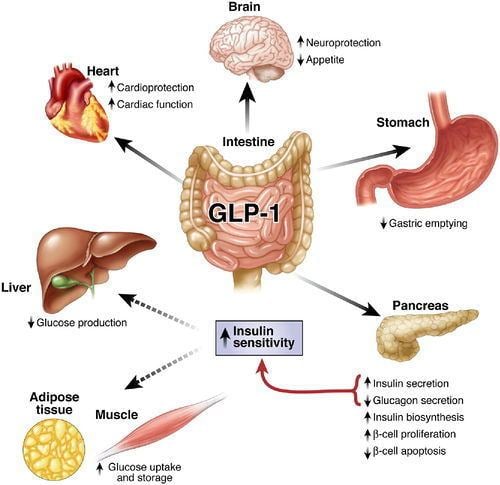 | ||
Glucagon like peptide 1 top 9 facts
Glucagon-like peptide-1 (GLP-1) is a neuropeptide and an incretin derived from the transcription product of the proglucagon gene. The major source of GLP-1 in the periphery is the intestinal L cell that secretes GLP-1 as a gut hormone; the major source in the brain is the nucleus of the solitary tract, which is the source of a widely distributed set of GLP-1 projection neurons. The biologically active forms of GLP-1 are: GLP-1-(7-37) and GLP-1-(7-36)NH2. Those peptides result from selective cleavage of the proglucagon molecule.
Contents
- Glucagon like peptide 1 top 9 facts
- Glucagon like peptide 1 glp 1 receptor agonists
- Visceral functions
- CNS functions
- Additional effects
- References
GLP-1 secretion by ileal L cells is dependent on the presence of nutrients in the lumen of the small intestine. The secretagogues (agents that cause or stimulate secretion) of this hormone include major nutrients like carbohydrate, protein and lipid. Once in the circulation, GLP-1 has a half-life of less than 2 minutes, due to rapid degradation by the enzyme dipeptidyl peptidase-4.
GLP-1 is a potent antihyperglycemic hormone, inducing the β-cells of the pancreas to release the hormone insulin in response to rising glucose, while suppressing glucagon secretion. Such glucose-dependent action is particularly attractive because an unregulated release of the hormone when the plasma glucose concentration is in the normal fasting range, or poorly-timed insulin injections, can cause a dangerous fall in blood glucose (hypoglycemia). This does not happen as a result of GLP-1 because GLP-1 no longer stimulates the β-cells to release more insulin when blood glucose levels are in the fasting range. Additionally, GLP-1 appears to restore the glucose sensitivity of pancreatic β-cells. The mechanism may involve increased expression of GLUT2 receptors on the surface of the β-cells; GLUT-2 is a carrier protein on the cell surface that facilitates the movement of plasma glucose across the cell membrane, allowing them to sense the level of glucose in circulation and release insulin when levels begin to climb. GLP-1 may also sensitize β-cells by increasing the expression of glucokinase, an enzyme in the β-cells that stimulates insulin production and release in response to glucose entering the cell. GLP-1 is also known to inhibit the programmed cell death (apoptosis) of pancreatic β-cells, and to stimulate β-cell proliferation and differentiation. In addition, GLP-1 inhibits gastric secretion and motility. This delays and protracts carbohydrate absorption and contributes to a satiating effect.
Glucagon like peptide 1 glp 1 receptor agonists
Visceral functions
GLP-1 possesses several physiological properties that make it (and its functional analogs) a subject of intensive investigation as a potential treatment of diabetes mellitus.
The known peripheral functions of GLP-1 include:
As evidence of the physiological role of GLP-1 in post-prandial insulin secretion, it has been shown that an oral dose of glucose triggers a much higher peak in plasma insulin concentration compared to an intravenous dose. Obese patients undergoing gastric bypass showed marked metabolic adaptations, resulting in frequent diabetes remission 1 year later. When the confounding of calorie restriction is factored out, β-cell function improves rapidly, very possibly under the influence of enhanced GLP-1 responsiveness. Outside of its function as an insulin secretagogue, GLP-1 seems also to play a role in bone physiology. Researchers evidenced a massive reduction in bone strength in GLP-1 receptor knockout mice mainly due to a poor bone quality.
CNS functions
The primary central nervous system functions of GLP-1 which are known include:
Additional effects
There is evidence that GLP-1 has direct and indirect functions in the immune system. Metabolic diseases (such as obesity and diabetes type II) are thought to have strong inflammatory underpinnings and vice versa, inflammation is often associated with metabolic changes. GLP-1 might be one factor explaining this link, since its production seems to be altered under inflammatory conditions.
